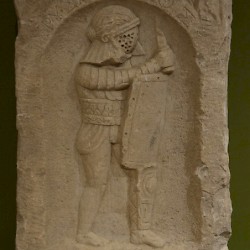Ancyra (Ankara)
Q3640Ancyra (Greek Ἄνκυρα): town in central Anatolia, capital of Galatia (modern Ankara).
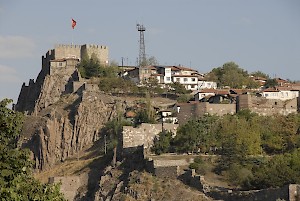
Iron Age
Ancyra is a very ancient town. Archaeologists have found objects from the Hittite Bronze Age and the Phrygian Iron Age on several places within modern Ankara. It was one of the stations on the Royal Road that originally connected the capitals of Assyria with central Anatolia (a/o Kaneš) and was later expanded to the Phrygian capital Gordium, to the Lydian capital Sardes, and to the Greek towns in the west and to the Persian capitals Susa and Persepolis in the southeast.
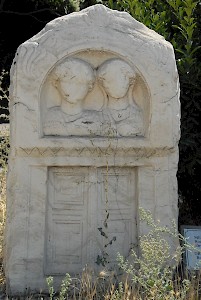
The Graeco-Roman author Pausanias (second century CE) tells about this early period that
Ancyra, a city of the Phrygians, was founded by Midas son of Gordius. And the anchor, which Midas found, was even as late as my time in the sanctuary of Zeus, as well as a spring called the Spring of Midas, water from which they say Midas mixed with wine to capture Silenus.note
This is just mythology, only meant to explain the name of Ancyra, which sounded like the Greek word for anchor. This may refer to a big rock, a baetyl, that resembled the type of stone that the ancients used as anchor.

The only thing that is certain is that the town was originally Phrygian and must therefore, after the demise of that kingdom, have become part of the Lydian Empire, which included all of Anatolia west of the river Halys. After about 547 BCE, Lydia became part of Achaemenid Persia, which in turn was subdued by the Macedonians of Alexander the Great. He must have passed through Ancyra in the spring of 333 BCE.
Hellenistic Age
After Alexander's death in 323 BCE, Central Anatolia was at first ruled by Antigonus the One-Eyed, who lost it to Seleucus I Nicator in the Battle of Ipsus (301 BCE). The Seleucids, however, were never able to formalize their rule.
After 275 BCE, the site was occupied by the Tectosages,note one of the Galatian tribes that had in the preceding years crossed into Asia from Europe, where their original homeland may have been close to the Pyrenees.note There is a famous anecdote that many centuries later, the Christian author Jerome passed through Galatia and observed that the people spoke a language reminiscent of the language spoken in Trier – which, unfortunately, cannot have been the Aquitanian Celtic tribe of the Tectosages. We do not know what to make of this anecdote, especially because the archaeological evidence shows that the Galatians picked up Greek culture very rapidly.
 Trajan |
 Ancyra, Balgat Tomb, wreath |
 Ancyra, Balgat Tomb, wreath |
 Ancyra, Balgat Tomb, box |
Roman City
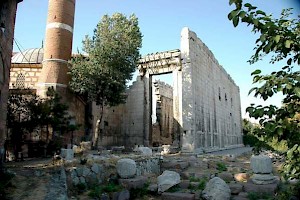
Pausanias tells us that later, the Pergamenes added Ancyra to their kingdom.note When the last king of Pergamon, Attalus III Philometor, left his kingdom to the Romans (133 BCE), the city became part of their zone of influence. Although contested for some time by king Mithridates of Pontus, Galatia remained Roman.
In 25 BCE, Ancyra was recognized as main city (metropolis) of the newly created province of Galatia. For the imperial cult, an existing sanctuary of the Anatolian deities Men and Cybele was converted into a temple for the emperor Augustus (r.27 BCE-14 CE) and the goddess Roma.
The city of the Sebasteni Tectosages Ancyrani (“the august Ancyran Tectosages”) was an important node in the network of Roman roads: it was a junction of the ancient Royal Road and a north-south road, guarded by a subunit of the Fifteenth Legion Apollinaris. The presence of soldiers and officials in the administrative center of Galatia meant that merchants could always sell all kinds of things. (One of the wealthy residences has been identified close to the residence of the Turkish president.) From Pausanias, quoted above, we learn about a sanctuary dedicated to Zeus and a place called “Spring of Midas”.
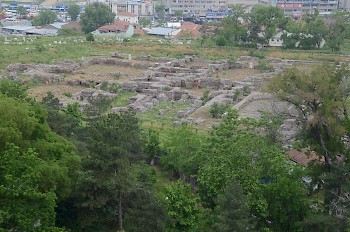
A colonnaded street was created in the second century. The “Balgat Tomb”, which was found near the Turkish Ministery of Foreign Affairs, dates to the same period. During the reign of the emperor Caracalla (r.211-217), a wealthy citizen named Tiberius Julius Justus Junianus donated a bathhouse, which is now known as the “Baths of Caracalla”. From coin finds, we can deduce that this complex remained in use for some five centuries.
Late Antiquity

Contested in the third century between the Roman and Palmyrene Empire, Ancyra remained an important city. When the emperor Diocletian (r.284-305) reorganized the Roman Empire, he kept it as a provincial capital, although Galatia was by now renamed Galatia Prima. Diocletian is also responsible for the largest persecution of Christians, which was continued by his successor Galerius (r.305-311). In 303, bishop Clement of Ancyra was executed, together with his brother and several members of their church. In the same year, one Theodotus was killed, together with his aunt Thecusa and Alexandra, Claudia, Euphrasia, Faina, Julitta, and Matrona. Four years later, in 307, the physician Plato and his brother Antiochus were executed.
Galerius put an end to the persecution shortly before his death in in 311. Three years later, Ancyra was the site of a major ecclesiastical synod, the minutes of which survive.
One monument from Late Antiquity is the Column of Julian, named after Julian the Apostate, the last emperor who defended paganism. It was erected during his visit in 362.
